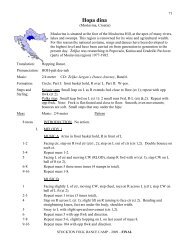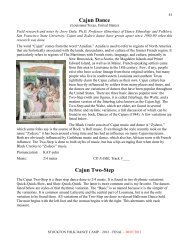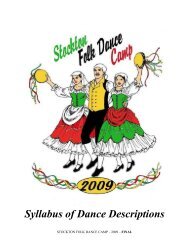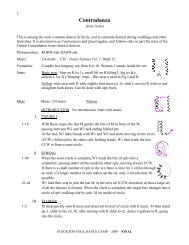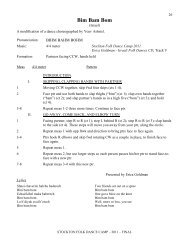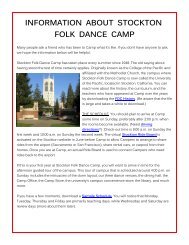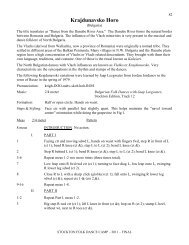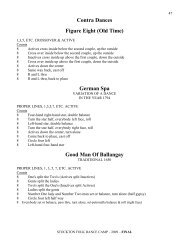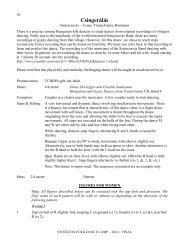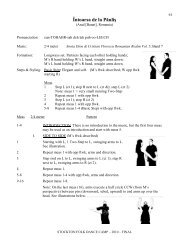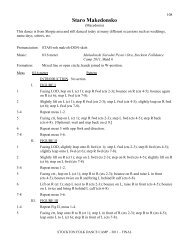Create successful ePaper yourself
Turn your PDF publications into a flip-book with our unique Google optimized e-Paper software.
Cajun <strong>Dance</strong><br />
(Louisiana/Texas, United States)<br />
Field research and notes by Jerry Duke, Ph.D, Professor (Emeritus) of <strong>Dance</strong> Ethnology and <strong>Folk</strong>lore,<br />
San Francisco State University. Cajun and Zydeco dance have grown apart since 1980-90 when this<br />
research was done.<br />
The word “Cajun” comes from the word “Acadian.” Acadia is used to refer to regions of North America<br />
that are historically associated with the lands, descendants, and/or culture of the former French region. It<br />
particularly refers to regions of The Maritimes with French roots, language, and culture, primarily in<br />
New Brunswick, Nova Scotia, the Magdalen Islands and Prince<br />
Edward Island, as well as in Maine. French-speaking settlers came<br />
from this area to Louisiana in the 18th century. Few, if any, people<br />
exist who have a clear lineage from those original settlers, but many<br />
people who live in southwestern Louisiana and southern Texas<br />
rightfully claim the Cajun culture as their own. Cajun culture has<br />
been heavily influenced by settlers from many places and times, and<br />
the dances are variations of dances that have been popular throughout<br />
the United States. There are three basic dances popular now: the<br />
Two-Step (with arm figures, it is called Jitterbug), the Waltz, and a<br />
modern version of the Jitterbug (also known as the Cajun Jig). The<br />
Two-Step and the Waltz, which are older, are found in several<br />
rhythmic and stylistic variations, a full discussion of which can be<br />
found in my book, <strong>Dance</strong>s of the Cajuns (1984). A few variations are<br />
listed below.<br />
The Black Creole cousin of Cajun music and dance is “Zydeco,”<br />
which some folks say is the source of Rock ‘n Roll music. Even though the style recently took on the<br />
name “Zydeco,” it has been around a long time and has had an influence on many Cajun musicians.<br />
Both are obviously influenced by Caribbean music and dance, which also has African roots with French<br />
influence. The Two-Step is done to both styles of music, but has a hip-swinging flair when done by<br />
Black Creoles to “Zydeco” music.<br />
Pronunciation: KAY-juhn<br />
Music: 2/4 meter CD NAME, Track #____<br />
Cajun Two-Step<br />
The Cajun Two-Step is a three step dance done to 2/4 music. It is found in two rhythmic variations:<br />
Quick-Quick-Slow, and Slow-Quick-Quick. The latter is more common and is my favorite. The dances<br />
listed below are styles of that rhythmic variation. The “Basic” is so named because it is the simpler of<br />
the variations. It is common around Lafayette and the central part of Louisiana, but is not the only<br />
variation to be found there. All variations of the Two-Step are done in relaxed Ballroom <strong>Dance</strong> hold.<br />
The man begins with the left foot and the woman begins with the right. This alternates with each<br />
measure.<br />
STOCKTON FOLK DANCE CAMP – <strong>2012</strong> – FINAL – 08/07/<strong>2012</strong><br />
41



